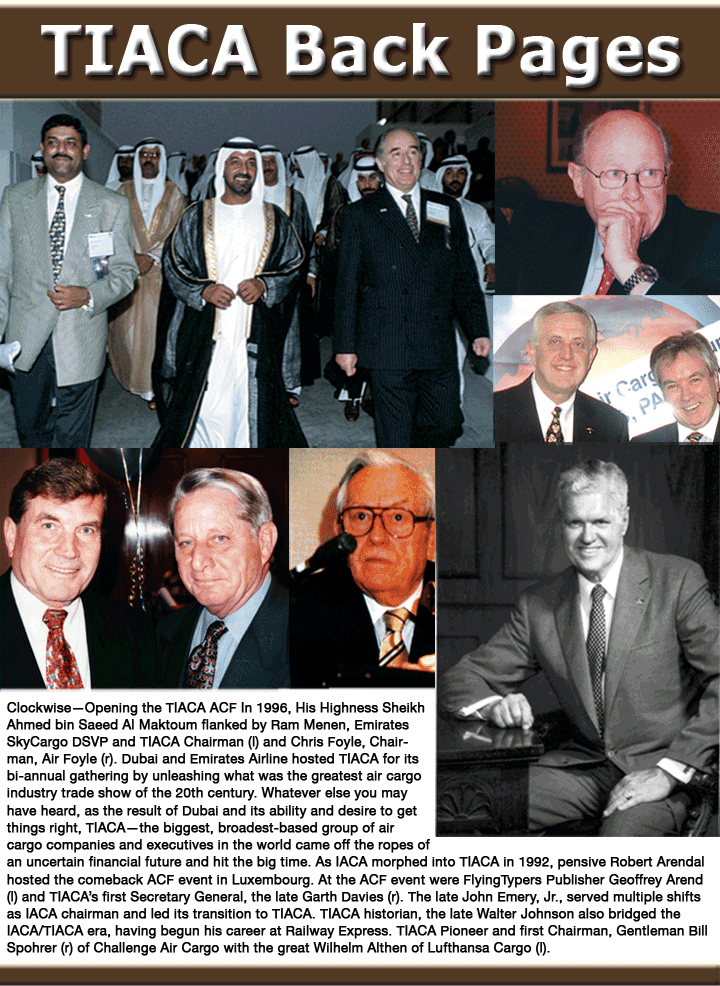|
TIACA Air Cargo Forum (ACF) in
Toronto October 16-18 premier air cargo event in the Americas during 2018.
The International Air Cargo Association
(TIACA) intends to further build the brand while also pursuing strategic
projects that improve supply chain flows for all air cargo stakeholders.
TIACA CEO
Scholte Is Action
Sebastian Scholte, CEO of Jan de Rijk Logistics,
moves onward into his two year tenure as TIACA chairman.
He replaced Sanjiv Edward, Head of Cargo
Business at Delhi International Airport. Speaking exclusively to Flying
Typers, Scholte said that under his leadership TIACA will take a multi-pronged
approached to growing the Association’s brand and building its role
as a facilitator of improved air freight supply chain efficiency and resilience.
Setting Up
A Pattern
“Strategy is about allocating your resources to the things that
give the best results,” he said. “And the best result would
be benefitting our industry and our members. And it should be achieved
in a financially sustainable way.”
Scholte has now set up a think tank of 15 industry leaders to help finalize
a strategy for TIACA with the aim of benefitting members and engaging
more with stakeholders.
Two Way Dialogue
“I’ve been talking to many people in the industry - members
and non-members.
“A lot of people are passionate about TIACA.
“It’s a very strong brand, and not only for now but also for
the future.
“People say cooperation in the air cargo supply chain is not working
as well it could and it would be perfect for TIACA to step in because
we are the only organization that represents the whole air cargo supply
chain. I’m not saying we will go down that route, but I envision
that TIACA will play a facilitating role to help improve supply chains.”
 |
CSG Launch
For Example
Illustrating the point, in October TIACA launched its Cargo Service Quality
(CSQ) initiative at its executive summit in Miami. CSQ is designed to
give an overall assessment of all service providers in a given airport
location as a means of generating qualitative data for users.
“I think that, and I may be dreaming a little bit, but it would
be wonderful if TIACA could somehow become Trip Advisor for air cargo,”
he said. “If you’re a shipper and you say, ‘OK I want
to ship pharmaceuticals, what are the best airports?’ then you will
have a resource – a ratings system for airports and service providers.
“Then if you go to an airport community, you can see how the handling
agents are rated, what kind of facilities they have for example for Pharma.
It’s not only that you have the customers evaluating the suppliers,
but not why not the other way around as well?”
Shippers
Advisory Panel
Mr. Scholte sees the initiative as working similarly to TIACA’s
Shippers Advisory Council, which has been working on how best to improve
information sharing and communication flow through the supply chain.
“We initiated this about two years ago and they have come up with
a logistics data backbone which basically improves the whole air cargo
supply chain and especially the information available,” he said.
“This is where we want to go, we want information sharing throughout
the whole chain so that we are more aligned with each other so we can
better plan and be prepared and therefore reduce errors, reduce costs,
and improve transparency in the supply chain.
Umbrella
Affect
“In future I see TIACA bringing all air cargo parties together,
under one umbrella, to help make supply chains perform better.”
“I think if we have a complete open source of information for everybody
where everybody can see everything, supply chains will function far better
and more transparently. There’s so much more room for improvement.
“I see TIACA playing a bigger role in this way and I think that’s
the only way to success. You can start small projects, help fund them
and then expand.”
ACF Is The
Money
Key to the Association’s ability to fund such initiatives is, of
course, TIACA’s bi-annual Air Cargo Forum. The previous ACF was
held in Paris in October last year and its follow-up will be hosted in
Toronto in October 2018.
Scholte said ACF was an integral part of the organization’s value
proposition as well as a key income-generator.
“TIACA is funded by its membership and, of course, by events, and
the Air Cargo Forum is a big contributor and has to be successful in order
for TIACA to remain economically viable.
Toronto ACF
This October
“Things went well in Paris – it’s a good location, easily
accessible.
Things are progressing well for Toronto also. The fact that it’s
in Toronto doesn’t mean it’s a Canadian event, it’s
a worldwide event. Global players meet global customers and global suppliers
and so on. It’s of course challenging to bring it all together,
and the cooperation that we have now with AFRAA (the African Airlines
Association) and talks we are having with ALACAT (the Federación
de Asociaciones Nacionales de Agentes de Carga y Operadores Logísticos
Internacionales de América Latina y el Caraibe) in South America
will help.
Forwarder
Initiative
“We are trying to get more forwarders to the event and we’re
doing everything to make it as attractive as possible for everybody. “There
will be shippers there, there will be good content, excellent networking
opportunities and we have to make it work.”
Air Cargo Forum is open to all. For more information please click here…
http://www.aircargoforum.org/
TIACA Into
Tomorrow
Scholte said there was more scope for building the TIACA brand beyond
its current strength in Europe and the US and, to a less extent Asia.
To this end, TIACA signed a Memorandum of Understanding (MoU) with AFRAA
in November, which will see the organizations work more closely on a range
of issues affecting air freight.
“We are expanding globally by acting more regionally,” he
said. “We are were trying to strengthen our ties regionally and
what that means is that we will exchange information and help each other
out with memberships etc.
“I believe in more closer cooperation with other organizations,
especially in those parts of the world where TIACA is not as well known.
“The more we all work together the better the overall air cargo
product will become,” Sebastian Scholte said.
SkyKing
|






 With
a fleet of 215 modern container ships, Hapag-Lloyd is recycling its older,
retired fleet, including this veteran of the seas, the “Heidelberg
Express,” which was handled in an eco-friendly manner at a specialized
shipyard in Alia?a, a town on the Aegean Coast of Turkey.
With
a fleet of 215 modern container ships, Hapag-Lloyd is recycling its older,
retired fleet, including this veteran of the seas, the “Heidelberg
Express,” which was handled in an eco-friendly manner at a specialized
shipyard in Alia?a, a town on the Aegean Coast of Turkey.
 Vol.
17 No. 7
Vol.
17 No. 7 Vol.
17 No. 8
Vol.
17 No. 8